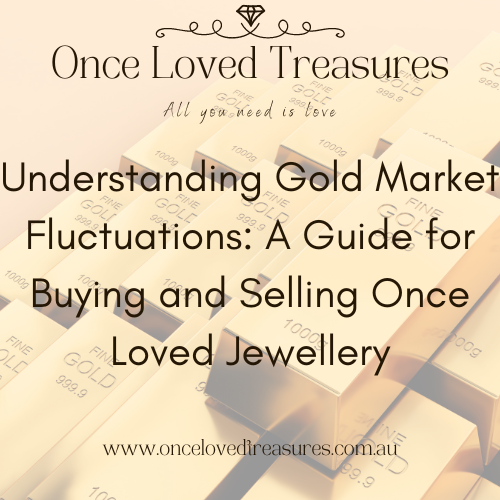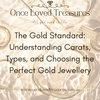
Understanding Gold Market Fluctuations: A Guide for Buying and Selling Once Loved Jewellery
Understanding Gold Market Fluctuations: A Guide for Buying and Selling Once Loved Jewellery
Welcome to Once Loved Treasures, where we celebrate the enduring allure of fine jewellery. Understanding the fluctuations in the gold market is crucial whether you are looking to sell your once loved jewellery for extra money or buy pre-loved pieces as an investment. This comprehensive guide will help you navigate the complexities of gold prices, resale values, and how to make educated choices in the gold jewellery market.
The Value of Gold: An Overview
What Determines the Value of Gold?
Gold has been a valuable commodity for centuries, prized for its rarity, durability, and beauty. Several factors influence the price of gold, making it a dynamic and often volatile market. Here are some key factors:
-
Economic Stability:
- Gold is often seen as a safe-haven asset during times of economic uncertainty. When stock markets are volatile, investors tend to buy gold, driving up its price.
-
Inflation:
- Gold is a hedge against inflation. When inflation rates are high, the value of currency decreases, and gold prices typically increase as a result.
-
Supply and Demand:
- Gold mining production and the demand for gold in industries such as jewellery and technology can influence prices. Limited supply with high demand drives prices up.
-
Geopolitical Events:
- Political instability, wars, and conflicts can lead to increased gold prices as people turn to gold for security.
-
Currency Fluctuations:
- The strength of the US dollar often inversely affects gold prices. When the dollar is strong, gold prices tend to drop and vice versa.
Understanding Gold Prices for Buying and Selling
Selling Your Once Loved Jewellery
When selling your gold jewellery, it’s important to understand the factors that will affect how much you can get:
-
Current Gold Prices:
- Stay updated with the current gold market price. Websites like Kitco and Goldprice.org provide real-time updates.
-
Gold Purity:
- The purity of your gold (measured in carats) significantly impacts its value. 24K gold is worth more than 18K or 14K because it has a higher gold content.
-
Weight:
- Gold is priced per gram or ounce. The heavier your piece, the more it is worth in terms of raw gold value.
-
Condition and Craftsmanship:
- Well-preserved, beautifully crafted pieces can fetch more than just their scrap gold value. Vintage or antique items might be worth more to collectors.
-
Brand and Designer:
- Jewellery from well-known designers or brands can command a premium over its intrinsic gold value.
Buying Pre-Loved Jewellery
Buying pre-loved jewellery can be a great investment if you know what to look for:
-
Gold Prices and Trends:
- Keep an eye on gold price trends. Buying when prices are low can save you money and offer better resale value in the future.
-
Authentication:
- Ensure the authenticity of the piece. Look for hallmarks, and consider getting an appraisal.
-
Condition:
- Assess the condition of the jewellery. Pieces in good condition with minimal wear and tear are more valuable.
-
Design and Style:
- Classic and timeless designs tend to retain value better than trendy pieces that may go out of fashion.
-
Rarity:
- Unique or rare pieces, especially vintage or antique ones, can be valuable investments.
Gold Value vs. Resale Value of Pre-Loved Jewellery
Gold Value
- Intrinsic Value: The intrinsic value of gold jewellery is based on the weight and purity of the gold. This is often referred to as the scrap gold value.
- Market Price: The market price of gold fluctuates daily based on the factors mentioned earlier. This price is quoted in ounces or grams.
Resale Value
- Condition and Demand: The resale value of pre-loved jewellery depends on its condition, design, and current demand in the market.
- Brand Premium: Pieces from well-known brands can sell for more than their gold content due to their design, craftsmanship, and brand prestige.
- Vintage and Antique Value: Vintage and antique pieces can have higher resale values due to their historical significance and rarity.
Retail vs. Second-Hand Prices
- Brand New Retail Prices: New jewellery typically includes a retail markup, which can be significant. This includes costs for design, manufacturing, marketing, and profit margins.
- Second-Hand Prices: Pre-loved jewellery usually sells for less than brand-new pieces. However, well-maintained or rare items can still fetch high prices, especially if they are from prestigious brands or are in excellent condition.
Making Educated Choices in the Gold Jewellery Market
Tips for Selling Gold Jewellery
- Research Gold Prices: Regularly check the current market price for gold. Websites like Kitco offer real-time updates.
- Get Multiple Quotes: Don’t settle for the first offer. Visit multiple jewellers and gold buyers to get the best price.
- Know Your Gold: Understand the carat and weight of your jewellery. This knowledge will help you negotiate better prices.
- Consider Selling Online: Online marketplaces and auctions can sometimes offer better prices than local jewellers.
Tips for Buying Pre-Loved Jewellery
- Check for Hallmarks: Ensure the piece is genuine by looking for hallmarks that indicate the gold’s purity and origin.
- Seek Certification: If possible, buy pieces that come with a certificate of authenticity.
- Inspect Condition: Carefully inspect the jewellery for any signs of wear or damage. Ask for high-resolution photos if buying online.
- Buy from Reputable Sellers: Look for sellers with good reviews and ratings. Reputable auction sites and established jewellers are good options.
- Understand the Market: Familiarise yourself with current trends and prices. This will help you spot good deals and avoid overpaying.
Understanding Gemstones in Second-Hand Jewellery
- High-Quality Gemstones: Only high-quality or large carat gemstones significantly affect the value of second-hand jewellery.
- Common Gemstones: Semi-precious stones or small diamonds typically don’t add much to the resale value.
- Certification: For valuable gemstones, look for certification from reputable organisations like GIA or AGS.
Checklist for Buying and Selling Gold Jewellery
-
For Sellers:
- Research current gold prices.
- Get multiple quotes.
- Know your jewellery’s carat and weight.
- Consider online selling options.
- Check for hallmarks and certifications.
-
For Buyers:
- Verify hallmarks and certifications.
- Inspect the condition thoroughly.
- Research the seller’s reputation.
- Understand the current market trends.
- Consider the overall design and style.
Conclusion
Understanding the fluctuations in the gold market is crucial for making informed decisions whether you are selling your once loved jewellery or buying pre-loved pieces. By keeping an eye on gold prices, researching thoroughly, and being aware of the factors that affect both the intrinsic and resale value of gold jewellery, you can ensure that you make the most out of your transactions. At Once Loved Treasures, we are committed to helping you navigate the gold jewellery market with confidence and find pieces that not only bring joy but also hold their value over time. Happy treasure hunting!

